Cithara
The cithara or kithara (Greek: κιθάρα, romanized: kithāra, Latin: cithara) was an ancient Greek musical instrument in the yoke lutes family. In modern Greek the word kithara has come to mean "guitar", a word which etymologically stems from kithara.[1]

The kithara was a seven-stringed professional version of the four-stringed lyre, which was regarded as a rustic, or folk instrument. As opposed to the simpler lyre, the kithara was primarily used by professional musicians, called kitharodes. The kithara's origins are likely Anatolian.[2](p185) The barbiton was a bass version of the kithara[3] popular in the eastern Aegean and ancient Anatolia.
Uses
The kithara was the virtuoso's instrument, generally known as requiring a great deal of skill.[4]
The kithara was played primarily to accompany dance, epic recitations, rhapsodies, odes, and lyric songs.[3] It was also played solo at the receptions, banquets, national games, and trials of skill. The music from this instrument was said to be the lyre for drinking parties and is considered an invention of Terpander. Aristotle said that these string instruments were not for educational purposes but for pleasure only.[4]
It was played by strumming the strings with a stiff plectrum made of dried leather, held in the right hand with elbow outstretched and palm bent inwards. The strings with undesired notes were damped with the straightened fingers of the left hand.[3]
Construction
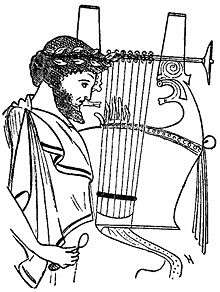
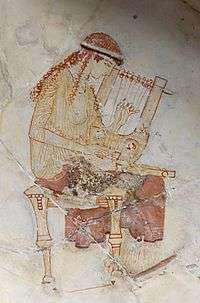
The kithara had a deep, wooden sounding box composed of two resonating tables, either flat or slightly arched, connected by ribs or sides of equal width. At the top, its strings were knotted around the crossbar or yoke (zugon) or to rings threaded over the bar, or wound around pegs. The other ends of the strings were secured to a tail-piece after passing over a flat bridge, or the tail-piece and bridge were combined.[3][2]
Most vase paintings show kitharas with seven strings, in agreement with ancient authors, but those same authors also mention that occasionally an especially skillful kitharode would use more than the conventional seven strings.[3]
Apollo as a kitharode
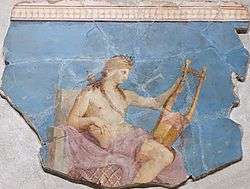
The cithara is said to have been the invention of Apollo, the god of music.[5] Apollo is often depicted playing a cithara instead of a lyre, often dressed in a kitharode’s formal robes. Kitharoidos, or Citharoedus is an epithet given to Apollo, which means "lyre-singer" or "one who sings to the lyre".
An Apollo Citharoedus or Apollo Citharede, is the term for a type of statue or other image of Apollo with a cithara. Among the best-known examples is the Apollo Citharoedus at the Vatican Museums, a 2nd century CE colossal marble statue by an unknown Roman sculptor.[3]
Sappho as a kitharode
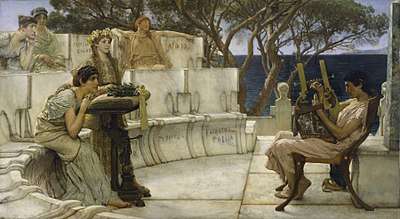
Sappho is closely associated with music, especially string instruments like the kithara and the barbitos. She was a woman of high social standing and composed widely popular songs that focused on the emotions.
A story from Greek myth goes that she ascended the steep slopes of Mount Parnassus where she was welcomed by the Muses. She wandered through the laurel grove and came upon the cave of Apollo, where she bathed in the Castalian Spring and took Phoebus' (Apollo's) plectrum to play skilful music. The sacred nymphs danced while she stroked the strings with much talent to bring forth sweet musical melodies from the resonant kithara.[6]
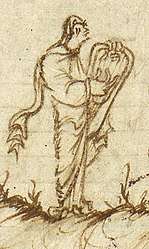

Famous cithara players
- Phrynis (Ancient Greek: Φρῦνις) of Lesbos, suda mentioned that the Phrynis was the first to play the cithara at Athens and won at the Panathenaea. By cithara is probably meant the new 12-stringed instrument invented by Melanippides of Melos.[7]
Other instruments called "cithara"
In the Middle Ages, cythara was also used generically for stringed instruments including lyres, but also including lute-like instruments.[8][9][lower-alpha 1][lower-alpha 2] The use of the name throughout the Middle Ages looked back to the original Greek kithara, and its abilities to sway people's emotions.[9]
Biblical references
The cithara is mentioned a number of times in the Bible, but generally mis-translated into English as "harp" or "psaltery". Psalm 42 in the Latin Vulgate (Psalm 43 in other versions), says, "Confitebor tibi in cithara, Deus, Deus meus,"[10] which is translated in the Douay-Rheims version as "To thee, O God my God, I will give praise upon the harp."[11] The King James version renders this verse as "Yea, upon the harp will I praise thee, O God my God."[12] The cithara is also mentioned in other places in the Latin Vulgate version of the Bible, including Genesis 4:21, 1 Kings (1 Samuel) 16:16, 1 Paralipomenon (1 Chronicles) 25:3, Job 30:31, Psalms 32:2, Psalms 56:9, Psalms 70:22, Psalms 80:3, Psalms 91:4, Psalms 97:5, Psalms 107:3, Psalms 146:7, Psalms 150:3, Isaiah 5:12, Isaiah 16:11, 1 Machabees 3:45, and 1 Corinthians 14:7.[13]
See also
- Ancient Greece
- Ancient Greek music
- Ancient Rome
- Barbiton
- Cythara
- Gittern, an instrument whose
name is derived from Kithara - Guitar
- Harp
- Kinnor
- Kitharode
- Lyre
- Phorminx
- Pandura
- Zither
Footnotes
- Cythara ... was often used as a generic term for 'plucked string instrument' by writers discussing a variety of instruments in medieval and Renaissance times ... [a musician using the word about his personal instrument would be] making a claim that his instrument was the one that had the magic to magically manipulate the listener's emotional states as the original kithara (with a similar large plectrum) had a reputation of doing to the ancient Greeks.[9]
- There is evidence of citharae shaped like a lute, that is with a neck and an elongated body, even before the 12th century: the Golden Psalter of St. Gall depicts King David wielding an instrument ... this instrument resembles a lute more than a cythara [lyre] ... Further evidence appears in the Stuttgart Psalter ... several images of an instrument ... in the text, next to all these miniatures, the instrument is called a cythara ... .[8]
References
- "guitar". Online Etymology Dictionary. Retrieved 25 October 2016.
- Maas, Martha; Snyder, Jane McIntosh (1989). Stringed Instruments of Ancient Greece. New Haven: Yale University Press.
- West, M.L. (1992). Ancient Greek Music. Oxford, UK: Oxford University Press. ISBN 0-19-814975-1.
- Aristotle. Politics. 1341a.
Aristotle calls it an organon technikon
- Pausanias. Description of Ancient Greece. 5.14.8.
- Anderson, W.D. (1994). Music and Musicians in Ancient Greece. Ithaca, NY: Cornell University Press. ISBN 0-8014-3083-6.
- Suda, phi.761
- Francesco Ciabattoni. "Dante's Journey to Polyphony".
- Segerman, Ephraim (April 1999). "A Short History of the Cittern". The Galpin Society Journal. 52: 78–79. doi:10.2307/842519. JSTOR 842519.
- "Latin Vulgate Bible, Psalms Chapter 42". www.drbo.org.
- "Douay-Rheims Bible, Psalms Chapter 42". www.drbo.org.
- "Psalms Chapter 43 KJV". www.kingjamesbibleonline.org.
- "Latin Vulgate Bible, Biblia Sacra Vulgata". www.drbo.org.
Further reading
| Wikimedia Commons has media related to Citharas. |
- Bundrick, Sheramy D. (2005). Music and Image in Classical Athens. New York: Cambridge University Press.
- Schlesinger, Kathleen (1911). . In Chisholm, Hugh (ed.). Encyclopædia Britannica. 6 (11th ed.). Cambridge University Press. pp. 395–397.
- "The Kithara in Ancient Greece | Thematic Essay". Heilbrunn Timeline of Art History. The Metropolitan Museum of Art. Retrieved 2016-10-25.
- Hagel, Stefan. "Ancient Greek Music". Vienna, Austria: Österreichische Akademie der Wissenschaften. Retrieved 2016-10-25.
External links
- Peter Pringle demonstrates how a kithara worked
- "Ensemble Kérylos". a music group directed by scholar Annie Bélis, dedicated to the recreation of ancient Greek and Roman music and playing instruments rebuilt on archaeological reference. In its recording D'Euripide aux premiers chretiens : musique de l'antiquité grecque et romaine, the band plays both Roman and Greek Kitharas. Pictures of its instruments can be seen on their website: Ensemble Kérylos. "Photos"..
